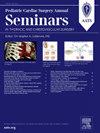单根和双根移位治疗大动脉转位和错位
Q2 Medicine
引用次数: 0
摘要
主动脉根移位和双根移位已成为复杂大动脉转位或双出口右心室合并室内外室流出道梗阻(LVOTO)的潜在有价值的手术选择。这些复杂的入路提供了极好的层状左室流出道,几乎没有后期左室再干预。虽然LVOT的优势是显而易见的,但与Rastelli手术相比,在延长手术缺血时间方面存在早期成本,甚至与LVOTO切除术的动脉切换相比。这似乎转化为一定程度的围手术期发病率。此外,对于双根易位,没有右心室-肺动脉导管的单根入路明显优于单根入路,应该得到证明。采用根移位不应以新主动脉功能不全或二尖瓣反流的较高发生率为代价,如一些系列报道。我们认为最好的结果可能是根据个体患者的解剖和病理生理来定制策略,特别是考虑到:原生肺动脉瓣的相对大小;LVOTO的复杂性;冠状动脉形态异常或相关病变。这些相对较新的技术的额外长期数据仍在等待中,尽管有一些早期的建议,对于最复杂的重建,可能会有一些晚发生的心力衰竭。对于特定患者,明智的术中评估通常是最佳方法的最终仲裁者。本文章由计算机程序翻译,如有差异,请以英文原文为准。
Single and Double Root Translocation for Transposition and Malposition of the Great Arteries
Aortic root translocation and double root translocation have emerged as potentially valuable surgical options for complex transposition of the great arteries or double outlet right ventricle with VSD and LV outflow tract obstruction (LVOTO). These complex approaches offer excellent laminar LV outflow tracts with almost no late LVOT reinterventions. Whilst the advantages for the LVOT are clear, there is an early cost in terms of prolonged operative ischemic times compared with the Rastelli procedure or even arterial switch with LVOTO resection. This appears to translate into a degree of perioperative morbidity. Further, concerning double root translocation, a clear benefit above a single root approach with no right ventricle-pulmonary artery conduit, should be demonstrable. Adoption of root translocation should not come at the expense of a higher incidence of neo-aortic incompetence or mitral regurgitation as has been reported in some series. We suggest that the best outcomes are likely to be achieved where the strategy is tailored to individual patient anatomy and pathophysiology, particularly taking into account: the relative size of the native pulmonary-to-aortic valve; complexity of LVOTO; and presence of abnormal coronary artery patterns or associated lesions. Additional long-term data for these relatively recent techniques are still awaited, although there are some early suggestions that for the most complex reconstructions, there may be some late occurrence of heart failure. Judicious intra-operative assessment is often the final arbiter for the best approach in a given patient.
求助全文
通过发布文献求助,成功后即可免费获取论文全文。
去求助
来源期刊

Pediatric Cardiac Surgery Annual
Medicine-Surgery
CiteScore
3.80
自引率
0.00%
发文量
7
期刊介绍:
The Pediatric Cardiac Surgery Annual is a companion to Seminars in Thoracic and Cardiovascular Surgery . Together with the Seminars, the Annual provides complete coverage of the specialty by focusing on important developments in pediatric cardiac surgery. Each annual volume has an expert guest editor who invites prominent surgeons to review the areas of greatest change in pediatric cardiac surgery during the year. Topics include 1) Complete Atrioventricular Canal; 2) New Concepts of Cardiac Anatomy and Function -- The Helical Heart; 3) Valve Reconstruction (Replacement) in Congenital Heart Disease; 4) Evolving Developments in Congenital Heart Surgery.
 求助内容:
求助内容: 应助结果提醒方式:
应助结果提醒方式:


